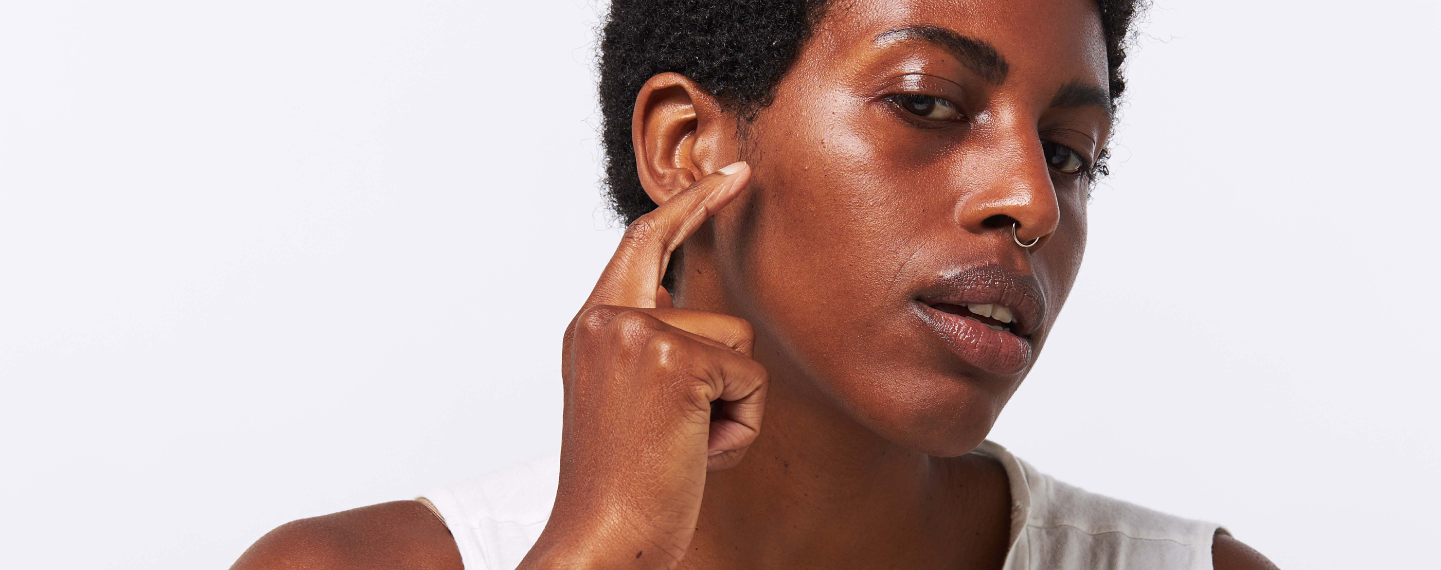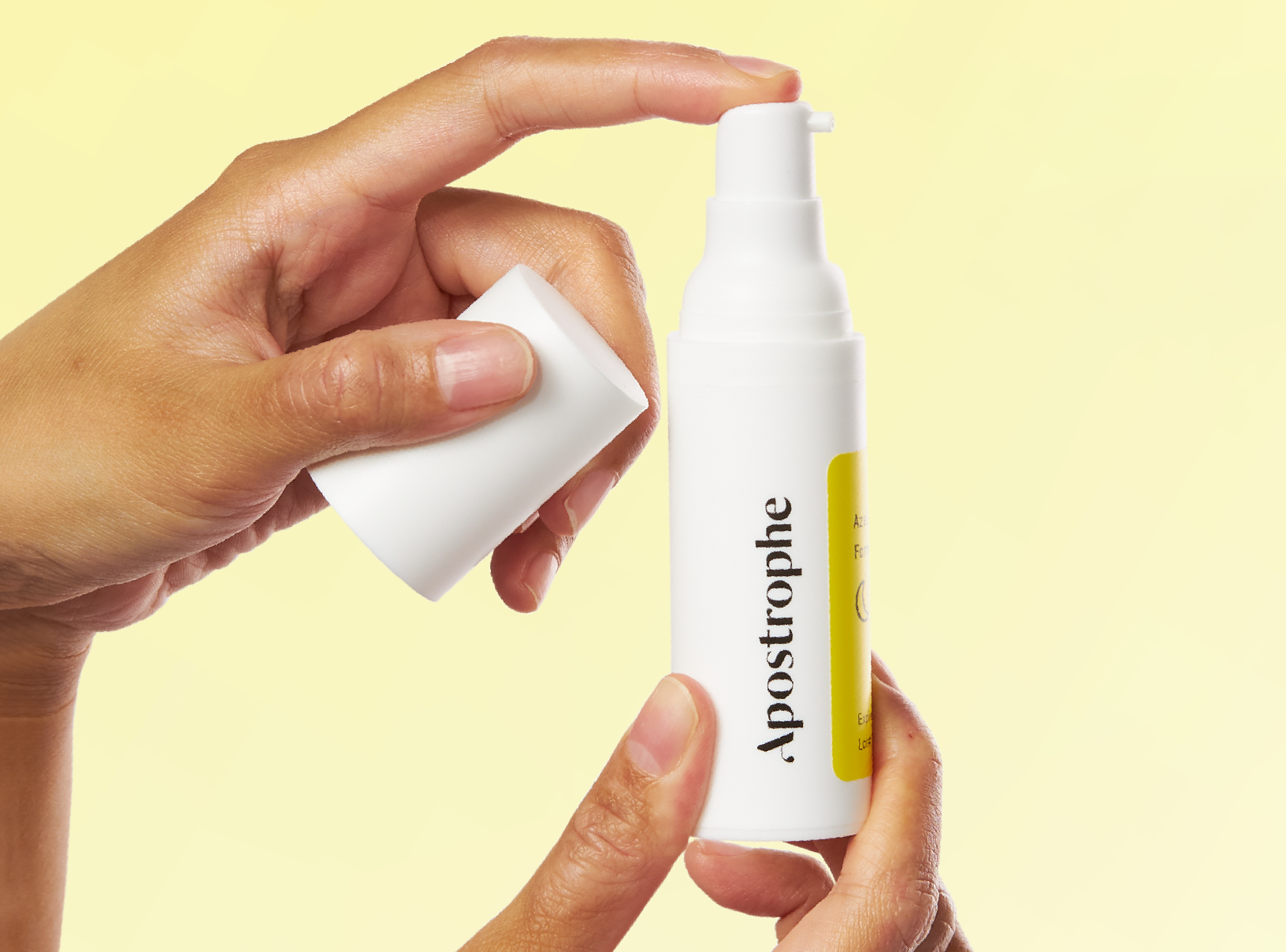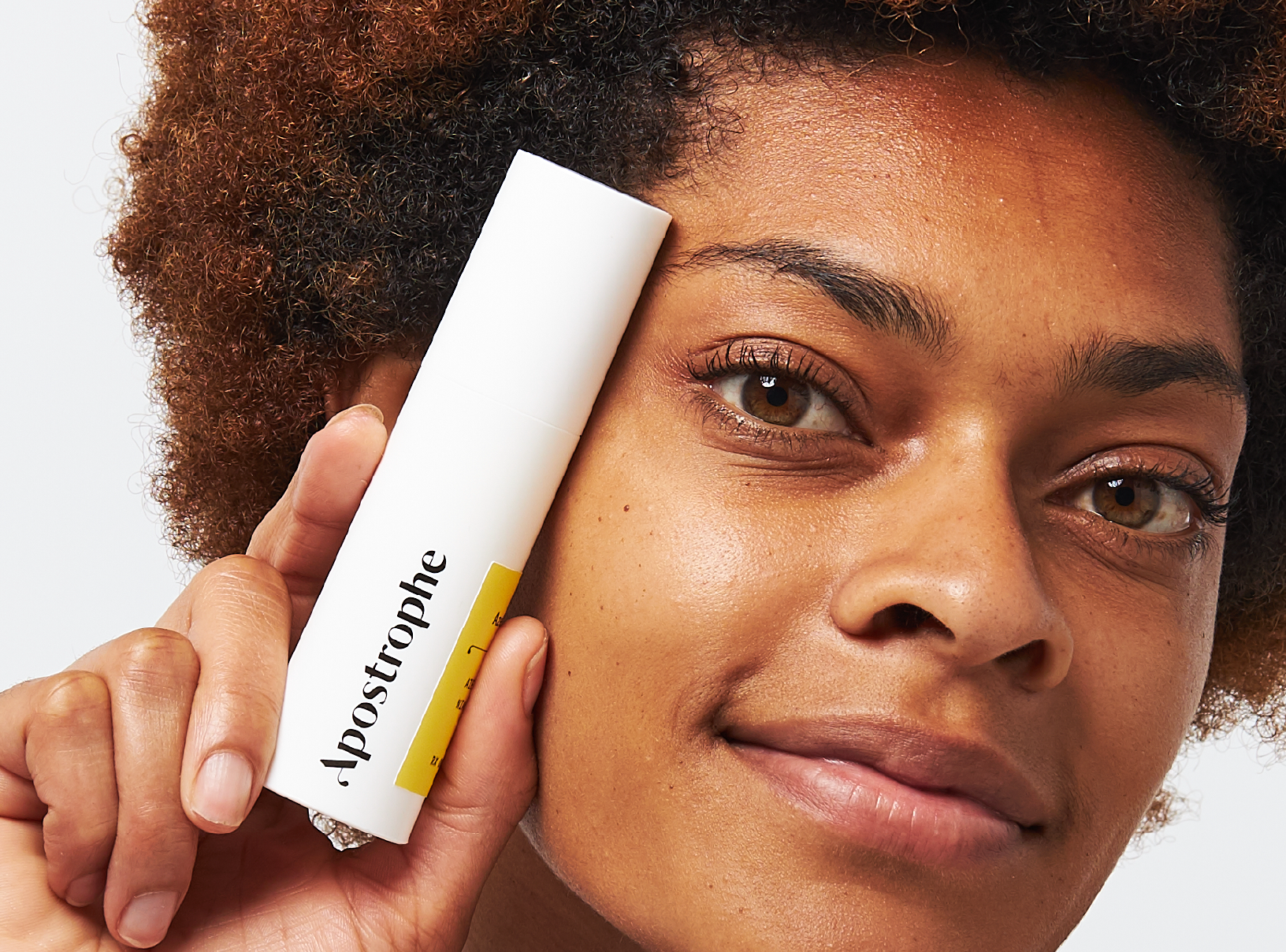Education
The Difference Between Fine Lines and Wrinkles


SHARE
Education
The Difference Between Fine Lines and Wrinkles
Medically reviewed by Vicky Davis, FNP
Written by Apostrophe Team
Last updated 11/3/2024
Wisdom can show up on your face as you age — and it’s normal to see shallow lines or deeper wrinkles develop near your eyes, on your forehead and at either side of your mouth.
In fact, fine lines and wrinkles are two of the most common issues that can affect your skin as you get older.
They often first appear in your 20s or 30s and gradually become more visible throughout your life.
Yet while fine lines and wrinkles look similar and are caused by the same factors, there are a few key differences between the two you might want to know.
Read on to learn more about the differences between fine lines and wrinkles along with how they develop.
You’ll also find information on effective treatments for fine lines, wrinkles and other signs of aging that can affect your skin.
What Are Fine Lines?
Fine lines are small, superficial wrinkles that can develop on your face, neck and other areas of your body.
They often form near your eyes, mouth and other areas of your face that move when you smile, laugh or make other facial expressions.
(Don’t freeze your face just yet, however. Expression is a fact of life!)
Unlike deep wrinkles, fine lines typically aren’t easy to see. You may only be able to notice fine lines when you look closely at your face in the mirror, or when you make expressions that cause your skin to form folds in certain areas of your face.
Many dermatologists define any wrinkles that measure less than 1mm in depth as fine lines, or fine wrinkles.
For many people, fine lines are some of the first visible signs of aging. Over time, shallow lines can deepen and become more visible if they aren’t actively treated.
What Are Wrinkles?
Wrinkles, or rhytides, are deeper creases or folds that form in your skin as a result of the aging process.
Healthcare professionals define wrinkles (or coarse wrinkles) as lines that penetrate more than 1mm into your skin.
Unlike fine lines (which can be difficult to spot) wrinkles are more visible.
Some wrinkles may be clearly visible when your face is in a neutral position, while others may become easier to see when you make certain facial expressions.
What Causes Fine Lines and Wrinkles?
As you grow older, a variety of different factors can lead to fine lines, wrinkles and other signs of aging on your skin.
Some of these factors are intrinsic, meaning they occur naturally as a result of your genes and metabolism.
Others are extrinsic, meaning they happen as a result of your lifestyle and other environmental factors.
Here are the most common causes of fine lines and wrinkles, as well as the role each plays in the aging process:
Intrinsic Skin Changes
To a certain extent, skin imperfections like fine lines and wrinkles are an unavoidable aspect of growing older.
This is because your skin naturally changes with time. As you get older, it’s normal for your skin to lose some of its fat content and gradually become thinner and less elastic.
New cells form at a slower pace and your body’s ability to supply nutrients to your skin weakens.
Combined with the effects of gravity, these changes can cause skin to sag and form fine lines and wrinkles.
Research has shown that skin thickness decreases by about 6.4 percent every decade, resulting in the gradual changes that occur as you get older.
Sun Exposure
While some aspects of the skin aging process are intrinsic, others are related to environmental and lifestyle factors.
By far the biggest extrinsic cause of skin aging is sun exposure. In fact, research suggests that exposure to UV radiation from sunlight is responsible for 80 percent of visible aging that affects your skin.
Sun damage harms your skin in several ways. It reduces collagen production and weakens the bond between the dermis (a connective tissue layer of skin) and the epidermis (the outer layer of your skin).
Long-term exposure to sunlight can also cause pigmentation changes that affect your skin tone and result in age spots and other forms of discoloration.
Facial Expressions
Some facial lines can form as a result of muscular contractions when you make facial expressions.
For example, dynamic wrinkles often form at the corners of your eyelids, between the eyebrows, and near your lips and forehead as a result of facial expressions such as squinting, smiling and laughing.
These often start as barely noticeable fine lines, but over time can form into deeper, more visible wrinkles.
Smoking
Smoking damages your skin and affects its ability to repair itself �— speeding the development of fine lines and wrinkles.
In one study, researchers found that cigarette smokers had lower skin elasticity and density than non-smokers.
Other research has found that smokers tend to have more significant facial wrinkling than people who don’t smoke.
How to Treat Fine Lines and Wrinkles
While it isn’t always possible to completely get rid of fine lines and wrinkles, most signs of aging can be reduced and made less visible with the right combination of skin care products and good habits.
Below are listed steps you can take to treat fine lines, wrinkles and other common signs of aging that affect your skin.
Limit Sun Exposure
The first step in treating fine lines and wrinkles is to prevent them from getting worse.
One of the most effective ways to lower your risk of developing fine lines and wrinkles is to limit the amount of time you spend in direct, bright sunlight.
When it’s sunny outside, you can limit your exposure to ultraviolet rays by spending your time in the shade.
And when you need to spend time outdoors, wear a wide-brimmed hat to shield your face from bright sunlight and protect your skin from UV damage.
Since tanning beds expose your skin to direct, concentrated UV radiation, they’re best avoided if you want to minimize fine lines and wrinkles.
Use Sun Protection
While avoiding bright sunlight is the best way to protect your skin from photoaging, sometimes spending time outdoors in peak sunlight hours is unavoidable.
When it’s bright and sunny outside, wear sun protection to keep your skin safe. Use an SPF 30+ sunscreen for any skin that’s exposed to sunlight, as well as UV-protective sunglasses to shield your eyes from direct sunlight and help you avoid squinting.
If you’re at the beach or swimming pool, pick a water-resistant sunscreen, or reapply sunscreen after you swim to keep your skin protected.
Stay Hydrated
Hydrated skin is almost always healthy skin. When you’re parched, you might notice that your fine lines, wrinkles and dark circles — as well as issues like dullness and uneven complexion — become a lot easier to see. So drink up.
To keep your skin hydrated, make sure to consume plenty of water throughout the day. Try to follow the CDC’s recommendations for water intake:
Drink water instead of sugary drinks.
Carry a water bottle throughout the day.
Opt for water when eating out.
Make sure to drink water with every meal.
Only drink alcohol in moderation, as it can cause dehydration.
Apply Moisturizer to Dry Skin
Moisturizer helps your skin retain water, adding volume and reducing the visibility of fine lines and wrinkles.
It’s best to apply moisturizer whenever your skin feels dry.
You may want to apply moisturizer on a frequent basis if you use acne treatments that contain salicylic acid, benzoyl peroxide or other ingredients that can dry your skin.
For best results, make sure to apply moisturizer as soon as possible after you wash your face or dry off following a bath or shower. This practice can help lock in moisture.
Use Over-the-Counter Wrinkle Treatments
If you��’re starting to notice fine lines or mild wrinkles, an over-the-counter anti-aging cream may be enough to help lighten their appearance and stop them from getting worse.
Several ingredients that have been scientifically proven to reduce fine lines and wrinkles can be found in over-the-counter skin care products. These include:
Hydroxy acids. Alpha-hydroxy acids (AHAs) and beta-hydroxy acids (BHAs) are widely used in over-the-counter anti-aging products. These ingredients work by removing dead layers of skin and promoting new skin cell growth.AHAs and BHAs can reduce the appearance of fine lines and wrinkles, improve your skin’s barrier function and promote firmer, more consistent skin.Common AHAs and BHAs include glycolic acid, lactic acid, tartaric acid, malic acid and salicylic acid.
Retinol. Retinol is an over-the-counter retinoid — a type of skin care medication derived from vitamin A. Research has found that it can produce significant reductions in wrinkles when used over a period of 12 weeks.You can find retinol in many anti-aging treatments, including creams, cleansers, serums and lotions.
Adapalene. Adapalene is another topical retinoid available over the counter. Research has shown that it’s effective at reducing the visibility of wrinkles and other signs of skin aging.Like retinol, adapalene is available in many over-the-counter anti-aging creams, as well as in Differin® gel, which is a topical acne medication.
Niacinamide. Niacinamide is a form of vitamin B3 that can be found in many anti-aging creams, lotions and masks. Research shows it can minimize the appearance of fine lines and wrinkles by increasing collagen and protein production in your skin.You can find niacinamide in many over-the-counter and prescription anti-aging products.
Caffeine. In addition to working as a helpful morning stimulant, caffeine has antioxidant properties that make it great for anti-aging. In fact, research has shown that when applied topically, caffeine can slow the aging process and offer protection against UV radiation.You can find caffeine in skin creams, lotions and other products.
Prescription Anti-Aging Products
While over-the-counter products can help lighten fine lines and shallow wrinkles, you’ll get the best bang from prescription anti-aging medications.
Good options include:
Tretinoin. Tretinoin is a versatile retinoid used for anti-aging and as a treatment for acne. It’s been used for decades, with countless studies showing it can reduce the visibility of wrinkles, improve skin texture and treat pigmentation issues.
Deep Wrinkle Treatments
Fine lines and light facial wrinkles are often easy to treat with over-the-counter and prescription creams. However, deep wrinkles can be much more stubborn.
If your wrinkles don’t seem to respond to topical products, you may want to look into cosmetic treatments.
Several clinical anti-aging treatments for fine lines and wrinkles are provided in person by healthcare professionals, including:
Botulinum toxin (Botox®). Botulinum toxin, or Botox, temporarily reduces the visibility of fine lines and wrinkles by blocking nerve signals to your facial muscles, stopping them from contracting.Botox injections are usually performed near the eyes, forehead and lips. You may need to repeat the procedure every few months for sustained results.
Dermal fillers. Dermal fillers restore volume and fullness in your face to make up for the subcutaneous fat loss that occurs with age. Fillers can soften the appearance of fine illness, wrinkles and creases that develop in your skin.Most dermal fillers last for several months, after which they’ll need to be injected again in order to prevent fine lines and wrinkles from returning.
Exfoliation procedures. These procedures involve exfoliating the skin using chemicals, dermabrasion instruments and other techniques. After the treatment, the outermost layer of your skin will grow back with a smoother texture and fewer imperfections.
Your Best Treatment for Fine Lines and Wrinkles
The main difference between fine lines and wrinkles is their depth. And while fine lines are generally shallow and difficult to notice, wrinkles tend to be deeper, larger and more visible.
Your best tactic for treating fine lines and wrinkles would be to take a multi-faceted approach, combining healthful habits with the right combination of skin care products.
For example, you can avoid ‘sleep wrinkles’ by sleeping on your back, and can help keep your skin hydrated (and more buoyant and ‘glowing’) by drinking at least eight glasses of water each day.
When it comes to anti-aging skin care, it’s also helpful to note you’ll get the best results by starting early.
Practice good skin care habits and you’ll be able to slow the aging process and enjoy healthy-looking skin in your 40s, 50s, 60s and beyond.
Worried about getting older? This guide to anti-aging skin care shares exactly what you can do to keep your skin looking, feeling and functioning its best at any age.
Like what you just read? Sign up for our email list to get the scoop on skincare science delivered straight to your inbox.

Deep Dives
A dermatologist shares his thoughts on the recent studies about benzoyl peroxide and benzene.
Read More
Education
What is milia?
What is milia? Today, we’re jumping into one type of bump that you may have heard about most commonly in infants — milia.
Read More
Education
Best moisturizer for acne-prone skin
If you have combination acne-prone skin, figuring out which moisturizer is best for your skin might be tough. In this guide, we break down the best moisturizer for combination, acne-prone skin.
Read More
